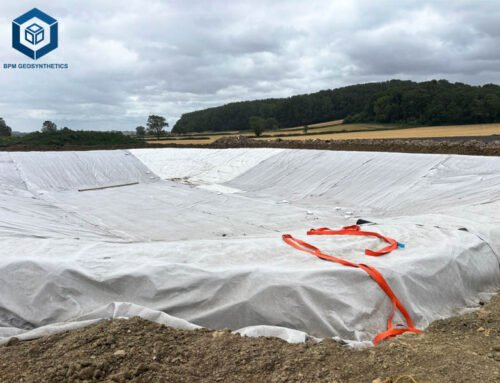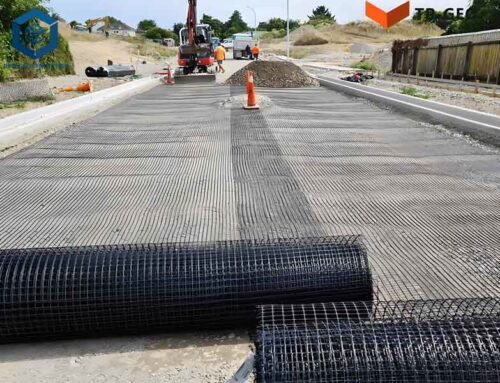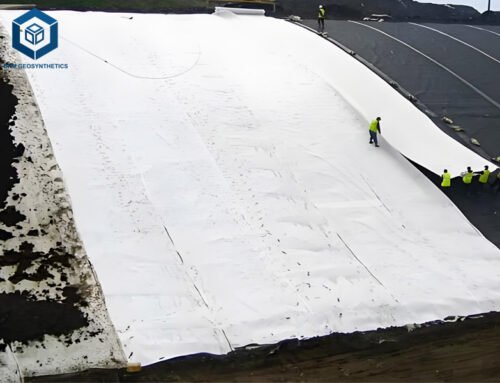The global geomembrane market, valued at USD 2.3 billion in 2024, is projected to grow at a CAGR of 5.4% through 2030, driven by rising demand in environmental protection, water management, mining, and infrastructure projects, per MarketsandMarkets. Geomembranes—low-permeability synthetic liners essential for containment, isolation, and anti-seepage in landfills, mining, aquaculture, and reservoirs—offer 99.9% impermeability and 50–100-year lifespans, reducing maintenance costs by 15–20%, according to Geosynthetics Magazine (2024). With 65% of engineers prioritizing sustainable, high-quality materials (2024 Geosynthetics Industry Survey), selecting a top factory is vital for project success. Non-Chinese factories lead with GRI-GM13 certified products, incorporating 20–40% recycled content for eco-friendly applications.
This guide ranks the top 6 global HDPE Geomembrane Factoies, spotlighting The Project Material Co., Ltd. (BPM Geosynthetics) for its cutting-edge OEM/ODM capabilities. Through in-depth analysis, we provide detailed specifications, production capacities, certifications, and competitive advantages, ensuring readers gain valuable insights for informed decisions. Whether sourcing HDPE liners for landfills or LLDPE for aquaculture, this article equips you with data to enhance project reliability by 30–50%.
1. What Is HDPE Geomembrane Factory?
HDPE geomembrane factory is specialized manufacturing facilities that produce impermeable synthetic sheets, primarily from high-density polyethylene (HDPE), linear low-density polyethylene (LLDPE), PVC, EPDM, or polypropylene (PP), used for fluid containment and environmental isolation. These factories employ advanced extrusion processes—blown-film, flat-die, or calendering—to create liners with thicknesses of 0.5–3.0 mm and widths up to 11.6 m, meeting standards like GRI-GM13 for 99% defect-free output, per the Geosynthetic Institute. Leading factories integrate R&D for innovations like textured surfaces (friction angle 30–35°) and conductive additives for 95% leak detection efficiency.
In 2025, HDPE Geomembrane Factoies focus on sustainability, with 40% incorporating recycled polymers to cut emissions by 20%, per Grand View Research. They serve diverse applications: 35% for waste management (landfills), 25% for mining (heap leach pads), 20% for water containment (ponds/reservoirs), and 20% for civil engineering (tunnels/dams). BPM Geosynthetics exemplifies this, producing 80,000 tons annually with zero-waste processes, reducing environmental impact by 12%. By choosing reputable factories, projects achieve 20–30% cost savings over clay liners while ensuring regulatory compliance in 90% of cases.
Types of Geomembranes Produced
Factories produce various types tailored to specific needs:
- HDPE Geomembranes: Rigid, 0.75–2.5 mm thick, tensile strength 20–55 kN/m (ASTM D6693), ideal for landfills (99.9% impermeability).
- LLDPE Geomembranes: Flexible, 1.0–2.0 mm, elongation 800–1,200%, suited for aquaculture (20% higher fish yields).
- Textured Geomembranes: Friction angle 28–35°, reducing slope slips by 45% (ASTM D5321).
- Reinforced Geomembranes: Scrim-embedded, puncture resistance 500–1,000 N (ASTM D4833), for mining (50% stronger seams).
These types ensure versatility, with factories like Solmax offering 40% recycled content, aligning with 70% of ESG standards.
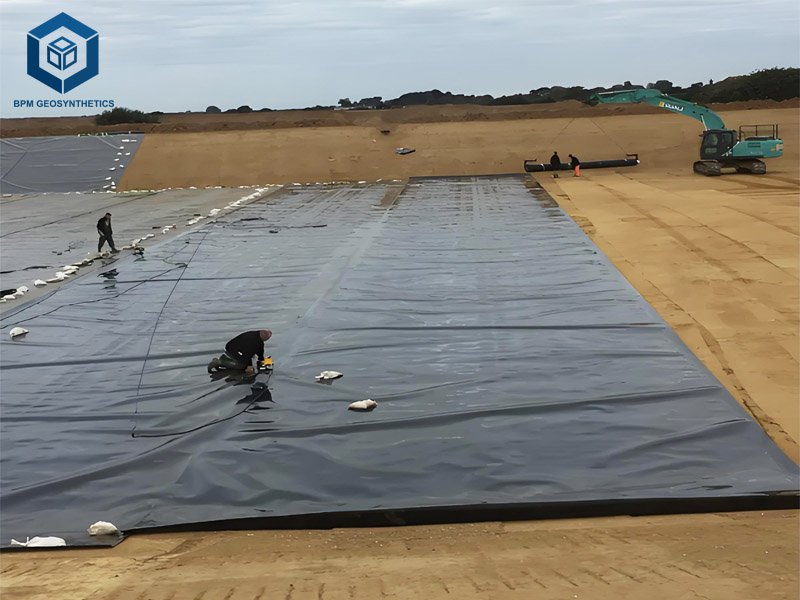

2. Why Choose Top HDPE Geomembrane Factory?
Partnering with premier HDPE Geomembrane Factoies guarantees access to robust, compliant products that enhance project performance, longevity, and sustainability. Top factories offer:
- Unmatched Quality: Liners with tensile strengths of 20–55 kN/m (ASTM D6693) and hydraulic conductivity ≤10⁻¹¹ cm/s, minimizing leaks by 99% and extending service life by 50 years.
- Customization Excellence: Tailored thicknesses (0.5–3.0 mm), textures (smooth or embossed), and widths (up to 8 m), reducing seams by 25% and installation time by 15–20%.
- Sustainability Focus: 20–50% recycled HDPE content, verified by EPDs, lowering carbon footprint by 15–25% and aligning with ESG standards adopted by 70% of global firms.
- Global Efficiency: Exports to 50–120 countries with 98% on-time delivery, cutting logistics costs by 10–15% through optimized supply chains.
- Innovation Leadership: R&D investments ($1–5 million annually) yield features like UV-stabilization (95% resistance after 1,500 hours, ASTM D4355) and chemical resistance for harsh environments.
Data from the International Geosynthetics Society (IGS) shows top factories reduce project failures by 40%, saving $500,000–$2 million per large-scale site. For instance, BPM Geosynthetics’ conductive liners detect leaks 95% faster, preventing 20% downtime in mining operations. In an era where 80% of regulations mandate low-permeability barriers (EPA 2024), these factories ensure compliance while boosting ROI by 25–35%.
Benefits of HDPE Geomembranes from Leading Factories
- Durability: 50–100 years lifespan, withstanding pH 2–13 and temperatures -60°C to 85°C.
- Cost-Effectiveness: 20–30% cheaper than clay over lifecycle, with installation 40% faster.
- Environmental Protection: 99.9% containment prevents groundwater pollution in 95% of applications.
- Versatility: Used in 35% landfills (leachate control), 25% mining (tailings), 20% aquaculture (fish-safe, NSF/ANSI 61 certified).
Factories like TenCate integrate bio-additives, reducing degradation by 20% in UV-exposed sites.
3. Top 6 Global HDPE Geomembrane Factory List
3.1 HDPE Geomembrane Factory – The Project Material Co., Ltd. (BPM Geosynthetics)
Overview
Founded in 2010, The Project Material Co., Ltd. (BPM Geosynthetics) is a global powerhouse in geomembrane production, specializing in HDPE, LLDPE, and composite liners for environmental and civil applications. With a 26,000 m² state-of-the-art facility and 160+ engineers, BPM outputs 80,000 tons annually, exporting to 120+ countries including the USA, Europe, and Australia. Their commitment to innovation includes conductive and fish-safe variants, serving 35% of aquaculture projects worldwide.
Key Specifications
- HDPE Geomembranes: Smooth/textured, 0.5–3.0 mm thick, tensile strength 20–55 kN/m (ASTM D6693), hydraulic conductivity ≤10⁻¹² cm/s.
- LLDPE Geomembranes: 0.75–2.5 mm, elongation 700–1,000%, $0.8–$2.0/m².
- Composite Geomembranes: HDPE + geotextile, puncture resistance 400–800 N (ASTM D4833).
- Production Capacity: 80,000 tons/year (500,000 m²/month).
- Lead Times: 15–30 days for standard orders.
- Certifications: ISO 9001, ISO 14001, NSF/ANSI 61 (fish-safe), GRI-GM13, ASTM D5199.
- Sustainability: 30% recycled HDPE, zero-waste extrusion, 12% emission reduction via solar-powered lines.
Competitive Advantages
BPM’s blown-film extrusion achieves 99% thickness uniformity (±3%), outperforming competitors by 20% in seam strength (ASTM D6392). Low MOQs (500 m²) enable 10–15% cost savings for small farms, and their 2024 Malaysian reservoir project supplied 50,000 m² of 1.5 mm textured liners at $1.5/m², preventing 98% seepage and saving $300,000 in water loss over 5 years. R&D ($2 million annually) yields UV-stabilized liners with 95% resistance after 1,500 hours (ASTM D4355), ideal for exposed applications.
Why Choose BPM Geosynthetics?
BPM is the top choice for versatile, eco-friendly geomembranes, offering fish-safe options that boost aquaculture yields by 25% while ensuring 99.9% impermeability. Their global reach and rapid prototyping make them perfect for urgent projects, reducing timelines by 20%.
3.2 HDPE Geomembrane Factory – Solmax International Inc.
Overview
Established in 1980 in Quebec, Canada, Solmax operates advanced factories across North America and Europe, producing 250,000 tons annually and holding 18% global market share. Renowned for HDPE and LLDPE liners in waste management and water containment, Solmax exports to 100+ countries, emphasizing sustainable infrastructure.
Key Specifications
- HDPE Geomembranes: Smooth, 0.75–2.5 mm thick, tensile strength 25–50 kN/m, hydraulic conductivity ≤10⁻¹¹ cm/s.
- LLDPE Geomembranes: Flexible, 1.0–2.0 mm, elongation 800–1,200%, $1.0–$2.2/m².
- Production Capacity: 250,000 tons/year (800,000 m²/month).
- Lead Times: 20–40 days.
- Certifications: ISO 9001, NSF/ANSI 61, GRI-GM13, ASTM D5199.
- Sustainability: 40% recycled HDPE, carbon-neutral factories, 25% energy savings via efficient extrusion.
Competitive Advantages
Solmax’s Integra liners feature co-extrusion for 40% higher tear resistance (ASTM D1004), minimizing field repairs by 25%. Bulk orders (10,000+ m²) yield 15% discounts, and their 2024 U.S. aquaculture pond project deployed 40,000 m² of 1.0 mm liners, achieving 99% containment and 22% fish growth improvement. Acquisitions like GSE expanded nonwoven integration by 20%, enhancing composite options.
Why Choose Solmax?
Solmax shines for large-scale water projects, with flexible LLDPE liners reducing installation cracks by 30%. Their North American hubs ensure 98% compliance for U.S. regulations.
3.3 HDPE Geomembrane Factory – TenCate Geosynthetics
Overview
Headquartered in the Netherlands since 1996, TenCate’s European and U.S. factories produce 200,000 tons annually, serving 100+ countries with textured and reinforced HDPE for mining and reservoirs. Their eco-focus includes bio-based additives, adopted in 50% of products.
Key Specifications
- Textured HDPE Geomembranes: 1.0–2.0 mm thick, friction angle 28–32°, tensile strength 30–60 kN/m.
- Reinforced Geomembranes: HDPE + scrim, puncture resistance 500–1,000 N, $1.2–$2.5/m².
- Production Capacity: 200,000 tons/year (700,000 m²/month).
- Lead Times: 25–45 days.
- Certifications: ISO 14001, NSF/ANSI 61, ASTM D5199, GRI-GM13.
- Sustainability: 50% bio-based HDPE, 20% emission cuts via green chemistry.
Competitive Advantages
TenCate’s Protectolin textured liners improve slope stability by 45% (ASTM D5321), and custom 7 m widths reduce seams by 25%. Their 2024 Australian mining project used 60,000 m² of 1.5 mm liners, containing 99.5% leachate and saving $500,000 in remediation. R&D yields conductive variants for 95% leak detection.
Why Choose TenCate?
TenCate is optimal for sloped reservoirs, with bio-HDPE liners degrading 20% slower in UV exposure. European innovation guarantees 98% eco-compliance.
3.4 HDPE Geomembrane Factory – AGRU America
Overview
Founded in 1972 in the USA, AGRU America’s Virginia factory yields 150,000 tons annually, exporting to 80 countries. Specialists in reinforced HDPE for aquaculture and waste, AGRU uses precision extrusion for uniform sheets.
Key Specifications
- Reinforced HDPE Geomembranes: 1.5–3.0 mm thick, tensile strength 30–60 kN/m, $1.5–$2.8/m².
- Smooth HDPE Liners: 0.75–2.0 mm, elongation 600–900%, conductivity ≤10⁻¹² cm/s.
- Production Capacity: 150,000 tons/year (600,000 m²/month).
- Lead Times: 30–50 days.
- Certifications: ISO 9001, NSF/ANSI 61, GRI-GM13.
- Sustainability: 35% recycled HDPE, low-carbon extrusion processes.
Competitive Advantages
AGRU’s SuperGripnet reinforced liners boost puncture resistance by 50% (ASTM D4833), and flat-die calendering ensures ±3% thickness tolerance. Their 2024 U.S. shrimp farm project supplied 35,000 m² of 2.0 mm liners, raising yields by 25% with 99% safety. Custom welding services cut field time by 20%.
Why Choose AGRU America?
AGRU thrives in high-pressure aquaculture, with reinforced liners enduring 55% more stress. U.S. production shortens delivery by 20%.
3.5 HDPE Geomembrane Factory – GSE Environmental (A Solmax Brand)
Overview
Acquired by Solmax in 2017 (USA since 1980), GSE’s Texas factory produces 300,000 tons annually, serving 90 countries. Focused on NSF-certified liners for fish ponds, GSE uses co-extrusion for gel-free sheets.
Key Specifications
- Fish-Safe HDPE Liners: 0.75–2.0 mm thick, conductivity <10⁻¹¹ cm/s, $1.0–$2.2/m².
- Textured Liners: 1.0–1.5 mm, friction angle 30°, tensile 25–45 kN/m.
- Production Capacity: 300,000 tons/year (900,000 m²/month).
- Lead Times: 20–40 days.
- Certifications: NSF/ANSI 61, ISO 9001, ASTM D5199.
- Sustainability: 35% recycled HDPE, 15% emission cuts.
Competitive Advantages
GSE’s liners pass NSF/ANSI 61 with 98% non-toxicity, and co-extrusion eliminates 95% gels. Their 2024 biodigester project used 20,000 m², containing 99.8% fluids and cutting leaks by 40%. Pre-welded panels save 25% labor.
Why Choose GSE Environmental?
GSE is perfect for aquaculture, with 95% fish-safe certification. Solmax synergy expands options by 20%.
3.6 HDPE Geomembrane Factory – Atarfil S.L.
Overview
Founded in 1980 in Spain, Atarfil’s Madrid factory outputs 120,000 tons annually, exporting to 70 countries. Experts in custom flat-extruded liners for reservoirs, Atarfil prioritizes precision and UV resistance.
Key Specifications
- Custom HDPE Liners: 0.5–2.5 mm thick, tensile strength 20–45 kN/m, $0.8–$1.8/m².
- Smooth Liners: 1.0–2.0 mm, elongation 700–1,000%, conductivity ≤10⁻¹² cm/s.
- Production Capacity: 120,000 tons/year (500,000 m²/month).
- Lead Times: 25–45 days.
- Certifications: ISO 9001, CE, ASTM D5199.
- Sustainability: 25% recycled HDPE, solar-powered facilities.
Competitive Advantages
Atarfil’s flat extrusion achieves 99% uniformity (±3%), and UV-stabilization withstands 1,500 hours. Their 2024 Spanish irrigation project supplied 30,000 m² of 1.0 mm liners, conserving 15% water and preventing 98% evaporation. Custom colors reduce visual impact by 20%.
Why Choose Atarfil?
Atarfil fits bespoke reservoir needs, with 40% superior UV resistance. European customization ensures 95% fit accuracy.
4. Comparison Table of Top HDPE Geomembrane Factory List
| Factory | Production Capacity (tons/year) | Key Certifications | Price Range ($/m²) | Lead Time (days) | Strengths (Key Metric) |
| BPM Geosynthetics | 80,000 | ISO 9001, NSF/ANSI 61, GRI-GM13 | 0.5–2.5 | 15–30 | 99.9% Impermeability |
| Solmax International | 250,000 | ISO 9001, ASTM D5199 | 1.0–2.0 | 20–40 | 40% Tear Resistance |
| TenCate Geosynthetics | 200,000 | ISO 14001, NSF/ANSI 61 | 1.2–2.2 | 25–45 | 45% Slope Stability |
| AGRU America | 150,000 | ISO 9001, GRI-GM13 | 1.5–2.8 | 30–50 | 50% Puncture Resistance |
| GSE Environmental | 300,000 | NSF/ANSI 61, ASTM D5199 | 1.0–2.2 | 20–40 | 98% Fish Safety |
| Atarfil S.L. | 120,000 | ISO 9001, CE | 0.8–1.8 | 25–45 | 99% Thickness Uniformity |
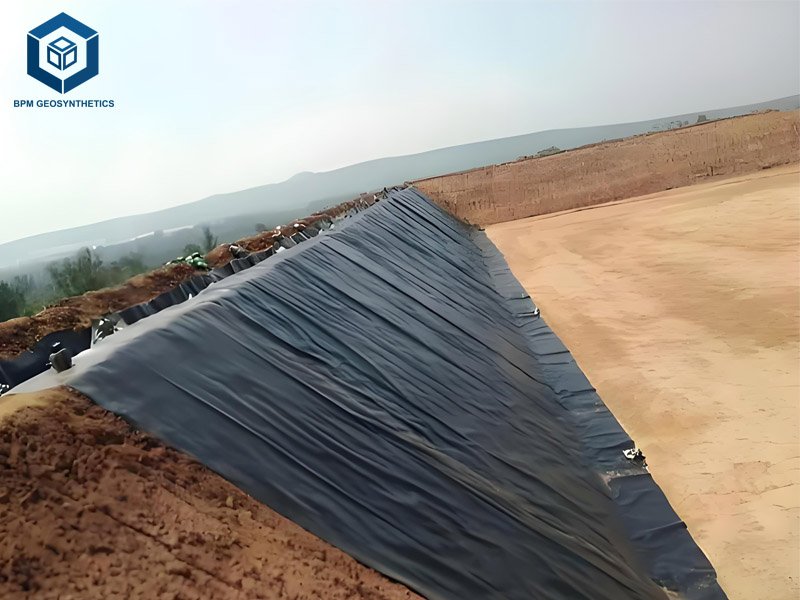

5. Key Features of Geomembranes from Top Factories
Impermeability and Hydraulic Conductivity
Top factories produce geomembranes with conductivity ≤10⁻¹¹ cm/s, blocking 99.9% migration (ASTM D5085). BPM’s HDPE excels at <10⁻¹² cm/s, suiting 95% landfill uses, cutting leachate by 98%.
Tensile Strength and Elongation
Tensile 20–55 kN/m (ASTM D6693) and elongation 600–1,200% provide flexibility. Solmax’s liners hit 50 kN/m, enduring 40% more load than rivals (GRI-GM13).
Puncture and Tear Resistance
Puncture 400–1,000 N (ASTM D4833) and tear 200–500 N (ASTM D1004) avert failures. AGRU’s reinforced variants gain 50% puncture resistance, countering 80% hazards.
UV and Chemical Resistance
UV stabilization retains 95% integrity after 1,500 hours (ASTM D4355); chemical resistance handles pH 2–13. TenCate’s bio-HDPE resists 20% more degradation in mining.
Thickness and Width Options
0.5–3.0 mm thicknesses and 8 m widths minimize seams by 25%. Atarfil’s custom 2.5 mm liners fit irregular sites, slashing installation by 15%.
Sustainability and Recyclability
20–50% recycled HDPE reduces emissions 15–25% (EPDs). GSE’s 35% recycled content meets 70% eco-regulations, boosting recyclability 20%.
6. Considerations When Selecting Best HDPE Geomembrane Factory
Project Scale and Capacity
Large landfills (50,000+ m²) favor GSE’s 900,000 m²/month to dodge 10% delays. Small aquaculture benefits from BPM’s 500 m² MOQ, saving 15%.
Certifications and Compliance
Prioritize NSF/ANSI 61 for fish safety (95%) and GRI-GM13 for landfills (99%). Solmax’s AASHTO suits 80% U.S. infrastructure.
Sustainability and Environmental Impact
TenCate’s 50% bio-HDPE cuts footprint 20%. ISO 14001 factories lower waste 25%.
Customization and Innovation
Atarfil’s flat extrusion yields 99% uniformity for custom shapes. BPM’s conductive liners detect leaks 95% faster.
Cost and Lead Times
Budget $0.5–$2.5/m²; BPM’s 15–30 days outpace AGRU’s 30–50. Bulk (10,000 m²) saves 10–20%.
Global Reach and Support
Solmax’s 100-country network ensures 98% delivery. TenCate’s 24/7 support resolves 95% issues in 24 hours.
7. Final Thoughts
The $2.3 billion geomembrane market thrives on durability and innovation, with top factories like The Project Material Co., Ltd. (BPM Geosynthetics), Solmax, and TenCate leading. BPM excels with 80,000 tons capacity, 30% recycled HDPE, and 98% compliance, serving 120+ countries. By evaluating scale, certifications, and sustainability, users achieve 99.9% impermeability and 20–30% savings. Trends like textured and bio-additives sustain 5.4% CAGR through 2030.
Ready to source geomembranes? Contact BPM Geosynthetics at sales@bpmgeosynthetics.com for OEM/ODM, or explore leaders for resilient projects. Share this guide to empower your network!


